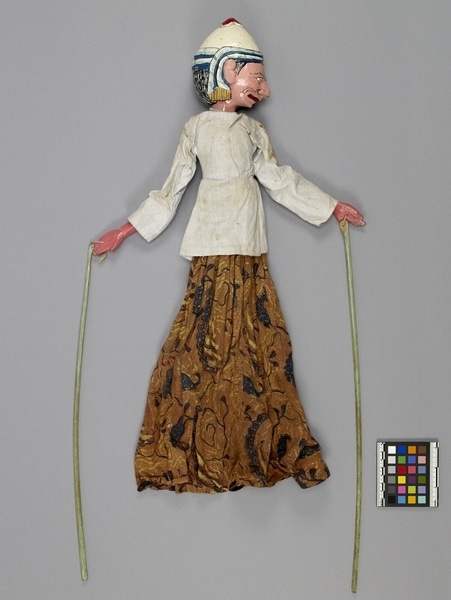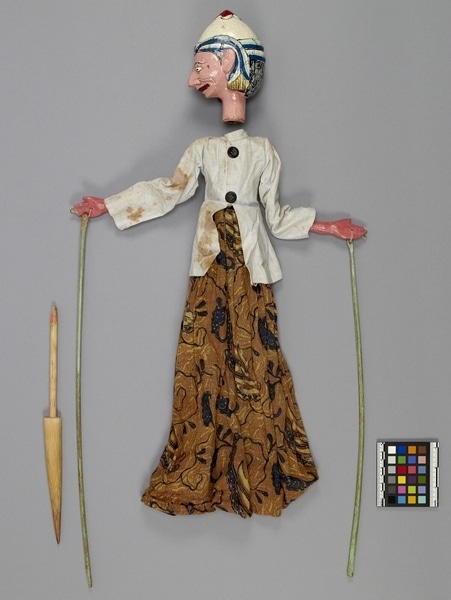Rod Puppet Item Number: Ib293 a-c from the MOA: University of British Columbia


Description
Three-dimensional male humanoid puppet: large head (part b) fits into body with tunic (part a), and a control rod (part c) with a long shaft passes through the body and fits into the neck of the figure's head. The body has jointed arms, each with a long, green controlling rod attached. The figure has a pink face and neck and small eyes looking downward, and a wide, downturned nose. Headdress consists of white painted turban, light and dark blue band surrounding it, red at top. Short black and white hair at back and at temples. Clothing of close-fitting off-white long-sleeved tunic with black buttons at back. Medium brown, dark blue and yellow batik patterned skirt. Straight hands with fingers held together.
History Of Use
Javanese puppetry as an art form probably developed by the 11th century. The three-dimensional wooden wayang golek puppets of western Java, which are to be distinguished from the earlier and more sacred wayang kulit shadow plays puppets or other forms, appeared during the 16th century. Originally the plays depicted Javanese mythology, but after the Indian conquest of Java the Hindu epics, Ramayana and Mahabharata, were incorporated into the cycles, which comprise about 200 plays. An individual or group hires a dalang (puppet-master) to celebrate important occasions. The performances often last all night and are generally presented in three acts, with vocal and instrumental accompaniment. The individual plays vary widely in detail but usually involve conflict between good and evil. They serve a moral and religious purpose, and more recently, one of political commentary. Each puppet's character is represented by its appearance and placement onstage; protagonists with strong elements of good are placed to the right, antagonists of violent or evil nature to the left. The role of this puppet is obscure, possibly intentionally, to allow the dalang to use it in differing minor roles or in scenes with large numbers of characters. The evident good and evil traits are useful in this way to allow a broad range of actions from the character.
Cultural Context
Theatrical performance.
Iconographic Meaning
Close-fitting tunic and batik skirt are representative of characters of wealth or nobility; pink face and small features indicate the puppet may belong to a group of secondary characters of refinement. Eyes cast downwards suggests restraint or humble nature. The position of the fingers indicate the full hand', a charm against evil. Red eyes, however, are not a positive attribute, more commonly associated with evil. Hands extended in this fashion are typically indicative of common people or demons; the puppet is not noble although some of its features are distinguished.
Item History
- Made in Java, Indonesia
- Owned by Tradewind Antiques before March 15, 1983
- Received from Museum of Anthropology Shop Volunteers (Funding source) and Tradewind Antiques (Seller) on March 15, 1983
What
Who
- Culture
- Sundanese
- Previous Owner
- Tradewind Antiques
- Received from
- Museum of Anthropology Shop Volunteers (Funding source) and Tradewind Antiques (Seller)
Where
- Holding Institution
- MOA: University of British Columbia
- Made in
- Java, Indonesia
When
- Ownership Date
- before March 15, 1983
- Acquisition Date
- on March 15, 1983
Other
- Condition
- fair
- Accession Number
- 0886/0027 a-c